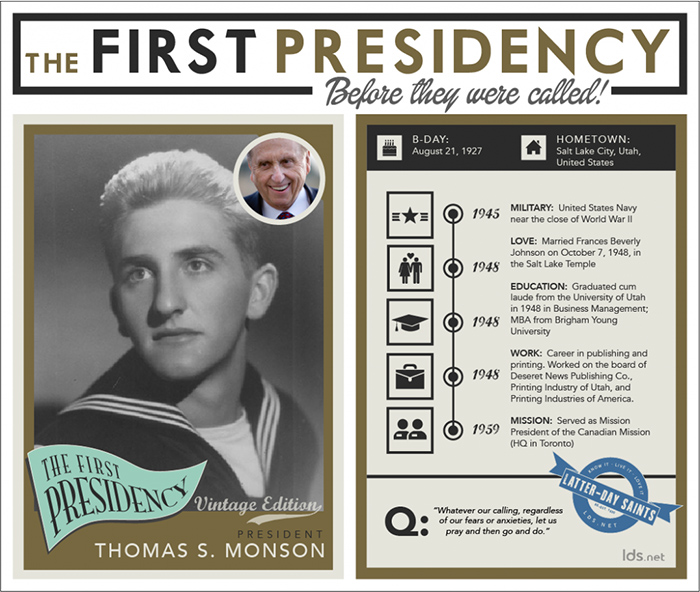The Remarkable Life of Thomas S. Monson
In memory of our recent Prophet, President Thomas S. Monson, we reflect on his life before he was Prophet. Our beloved prophet passed away peacefully, surrounded by his family at age 90 the evening of January 2, 2018.
Tommy, a little boy who made mischief, but had a heart of gold, once said, “decisions determine destiny” (New Era article “Decisions Determine Destiny”). May we never forgot his powerful words and always remember the legacy of our beloved Prophet.
Serving His Fellow Man
Learning Service From His Parents
Ever since young Tommy Monson could remember, there were always hungry hobos in his home. Even though the Great Depression made money hard to come by, Tommy’s mother, Gladys Monson, always welcomed these wandering young men with open arms and a hot meal. Tommy’s family shared dinner with the hobos while listening to Gladys as she gave them advice along with the food. She told them to write to their mothers and return home (To the Rescue).
Tommy’s mother didn’t give food just to these occasional strangers, but to neighbors like Old Bob. He was a lonely, old widower who lived next door in a home that Tommy’s grandfather had given him. Every Sunday, Gladys sent Tommy over to Old Bob’s with a hot meal before Tommy could eat his own dinner.
Tommy, feeling impatient and hungry, once asked his mother if he could take food over to Old Bob after he had eaten his own meal. All he got from his mother was a gentle scolding of, “you do what I say, and your food will taste better.”
Tommy walked over to his neighbor’s home with the meal in hand. Old Bob tried to give Tommy a dime for the delivery, but Tommy knew better and told Old Bob that he couldn’t accept the money because his mother would tan his hide. Old Bob only said “my boy, you have a wonderful mother.” Tommy went home with Old Bob’s words in mind. As he ate his dinner, he realized Gladys had been right: his food did taste better when he gave to Old Bob first (New Era article “The Joy of Service”).
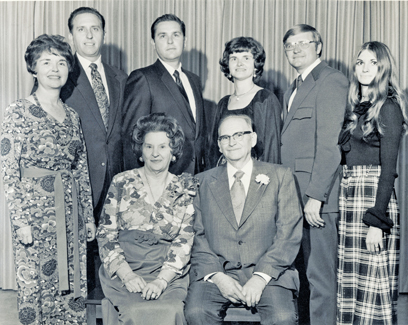
Tommy’s father, Spence Monson, served others as well. Every Sunday, Spence and Tommy drove over to Uncle Elias’s home. Uncle Elias’s body was so crippled with arthritis, that he could hardly walk or leave his house. Spence would carry Elias to their car and drive it around, so Elias could enjoy seeing the city.
President Monson later said that “Father never read to me from the Bible about the good Samaritan. Rather, he took me with him and Uncle Elias in that old 1928 Oldsmobile and provided a living lesson I have always remembered” (Liahona article “President Thomas S. Monson: In the Footsteps of the Master”).
Sacrificing Desires: Christmas Train
Tommy wanted an electric train and waited in eager anticipation for its arrival one magical Christmas morning. Under the Christmas tree, Tommy unwrapped the long-awaited electric train.
Tommy saw that his mother had purchased another gift as well, a simple wind-up train. She explained that this train was for the neighbor boy, Mark Hansen, whose mother was a widow. Even though it was merely a wind-up train, Tommy noticed it had an oil tanker that his electric train did not. He asked Gladys if he could have Mark’s oil tanker, wanting to further improve his own train.
Gladys told Tommy that he could have it “if you need it more than Mark.” Tommy did think he needed the tanker more than Mark, so with what he thought was his mother’s blessing, he attached the tanker to his electric train.
Later that day, Tommy accompanied his mother to the Hansen home to deliver Mark’s gift. Tommy could see Mark was thrilled with the gift, even though it was only a wind-up train. Tommy knew that Mark didn’t realize there was a missing car, but he still felt guilty for his actions earlier that day as he saw the happiness on Mark’s face.
“Wait just a moment—I’ll be right back,” Tommy told his mother before rushing home. Tommy not only grabbed the oil tanker, but another car from his electric train as well. When he returned to the Hansens, he gave Mark the two cars and explained that they had forgotten them. President Monson later said that he “felt a supreme joy difficult to describe and impossible to forget” (“Thomas S. Monson: Sixteenth President of the Church”).
Giving to the Hungry: Thanksgiving Rabbits
On Thanksgiving day, Tommy heard his neighbor friend, Charlie Renshaw, calling his name from over the fence. Tommy ran over to Charlie, who asked what smelled so good in the Monson home. Tommy told him it was turkey, and Charlie asked what turkey tasted like.
Tommy responded with the universal answer of it tasting “like chicken,” and Charlie asked what chicken tasted like. Tommy went back into his home to grab some turkey meat for Charlie to try. “That’s good!” Charlie exclaimed after eating the meat.
Tommy asked what Charlie was eating for Thanksgiving dinner. Charlie said that he didn’t know because there was nothing in his house to eat. Tom remembered how his mother always fed the hobos, even when she had little to offer. But Tommy didn’t have any turkeys, chickens, or even money to give Charlie. He didn’t know how to help his friend.
Then Tommy remembered his pet rabbits, two beautiful New Zealand Whites he loved. Tommy put his rabbits in a bag and gave them to Charlie. He told him that rabbit meat tasted better than chicken, and he could sell the rabbits’ hides for money. Though the beloved rabbits were the only thing Tommy had, he gave them to a friend who had never tasted turkey or chicken meat before (To The Rescue).
Charity to the Enemy: Baseball Wars
Tommy and his friends were at constant odds with his neighbor, Mrs. Shinas, who was very cross and often scolded the boys. But the biggest issue lay with her baseball thievery.
Tommy spent many long, wonderful hours playing baseball with his friends on a makeshift field near his home. But disaster always struck if they hit the ball too far to the right. If a baseball landed anywhere near Mrs. Shinas’s porch, she would snatch it up and take it inside her home. The boys would never see the ball again.
Tommy and his friends retaliated to Mrs. Shinas’s baseball thievery by pranking her. She stole their baseballs, and they pranked her. This cycle in the baseball war continued until it came to a standstill; because the boys had no more balls left to play with. But then Tommy took an offensive maneuver no one ever expected: he watered Mrs. Shinas’s lawn.
One day, while watering his own lawn, he decided to spare Mrs. Shinas the trouble and watered hers as well. Months passed, and Tommy continued to water her lawn, and later rake leaves off of it. Then one day, Mrs. Shinas called a truce to the baseball war by inviting Tommy into her home for milk and cookies. Mrs. Shinas thanked Tommy for being kind to her and gave him a box full of the baseballs she had held captive over the years (Friend article “Baseballs and Service”).
Fun Times and Funny Stories
Troublemaker Tommy
Tommy loved to help and serve others. But as a young boy, he would sometimes misbehave, cause mischief, and make trouble. He just liked to pull pranks, having a sense of fun still seen in him today.
One day, his primary president, Sister Georgell, asked if she could speak with him after church. They sat down, and she amazed Tommy by starting to cry. Tommy asked what was wrong, and listened as Sister Georgell told him that there were some boys in primary who kept misbehaving, and she did not know what to do.
“Innocently, I asked, ‘May I help, Sister Georgell?’ With a smile on her face and a twinkle in her eye, she responded, ‘Would you?’ ” Tommy was able to solve Sister Georgell’s problem, primarily because he was at the center of it (“Thomas S. Monson”).
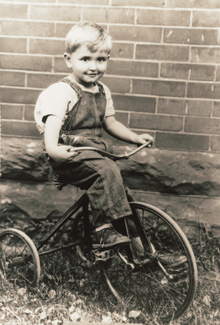
Mischief in Provo Canyon
Tommy loved nothing more than spending time at his family’s cabin in Provo Canyon’s Vivian Park. He enjoyed fishing, tubing down the river, and playing with his friend, Danny Larsen. One day, they decided to have a fire for all of their friends to enjoy.
Tommy and Danny needed to clear grass out of a field for their fire. They pulled handful after handful after handful of grass, but the small handfuls made little difference in the huge field. Tommy and Danny soon became tired and disappointed. The task was too hard and would take too long.
Then Tommy got an idea. What if they just burned away the grass? That would quickly give them the clearing they needed with no effort on their part. Danny agreed to the idea and Tommy went to get some matches. Thomas S. Monson later said that “I recall thinking that the fire would burn only as far as we wanted and then would somehow magically extinguish itself.”
To the boys’ delight, the dry grass lit instantly. But their delight soon turned to fear as the flames quickly spread and became out of control. Tommy and Danny rushed to get their parents, who spent many hours putting out the dangerous fire (General Conference talk “Obedience Brings Blessings”).
Tommy loved to play pranks, especially on his older sister, Marge. Another time in Provo Canyon, Tommy and Danny spied Marge dozing by the river with some friends. They couldn’t resist the temptation of a sneak attack. Tommy and Danny rolled up two live frogs in mud balls and dropped them on Marge and another girl.
The mud balls exploded spectacularly and the frogs jumped up into the girls’ faces. Two boys that were with Marge responded by throwing Tommy and Danny into the river, yelling “sink or swim” (To the Rescue).
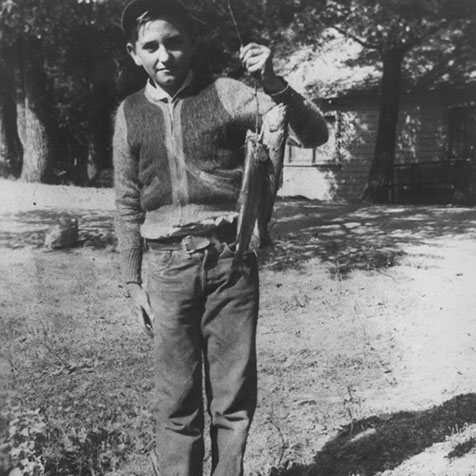
Mans’ Best Friend . . . Sort of
Tommy wanted nothing more than a dog. He and his cousin decided to remedy this by collecting all of the stray dogs in the city with a wagon and a box. They soon had lots of dogs and no idea what to do with them. The ideal solution seemed to be hiding their new-found pets in the coal shed. This solution worked well until Spence Monson went to collect coal and was nearly bowled over by six dogs.
This wasn’t the last time dogs caused trouble for Tommy. One day, he and his friends came upon the truck of an abominable dog catcher. The boys didn’t want to see the poor dogs locked up in the pound, so they decided to save them and set them free. The dogs then showed their gratitude by chasing the boys down the street for several blocks.
Early in his marriage, Tom put an ad in the paper for a springer spaniel, a dog he wanted to train to hunt. He got a call from a man who told him of a new breed of dog, a german shorthaired pointer, that was the best type of hunting dog. The man was very convincing, so Tom bought the dog for a pricey $25.
However, the dog gave Tom nothing but trouble and seemed impossible to train. Tom’s grandfather observed his training attempts and asked him how much he had paid for the dog. Tom didn’t want to admit to the $25, so he told his grandfather that he had only paid 5. His grandfather responded, “ya darn fool. You paid four dollars and six bits too much.”
The dog soon proved to be too much of a hassle, so the Monsons’ gave him away. However, the man who purchased the dog returned a couple of days later, unable to handle him. The Monsons’ tried to give the dog away again, but with the same results. Finally, they had success with an Idaho farmer who would later tell them (much to their amazement) that the dog was “the best hunting dog ever” (To the Resuce).
Courtship and Marriage
First Meeting Frances
Tom met Frances Beverly Johnson during his first year attending the University of Utah. He was at a school dance when he saw her pass by with a date. For him, it was love at first sight, or at least a very strong interest at first sight. “I just took one look and decided that there was a young lady I wanted to meet. But she danced away. I might never have seen her again.”
But Tom did see her again a couple of months later. While waiting for a streetcar, he spied Frances with another young woman and a young man Tommy recognized from grade school days. Tom knew that the young man was the perfect way for Tom to get introduced to Frances. There was only one problem: Tom could not remember the young man’s name.
Tom opted for a brave and bold approach by walking up to them and saying, “hello, my old friend from grade school days.” Unfortunately for Tom, all he received was a blank look on the young man’s face. The young man then admitted that he couldn’t quite remember Tom’s name. Tom introduced himself, and in turn was introduced to Frances (New Era article “Whom Shall I Marry?”).
First Date
Tom’s first date with Frances had a surprising twist he never expected. When Frances introduced Tom to her parents, Brother and Sister Johnson, her father asked Tom if “Monson” was a Swedish name. Tom told him it was, and Brother Johnson retrieved a picture of two missionaries and asked if Tom was related to one of them, an Elias Monson.
When Tom explained that Elias was his grandfather’s brother, Brother Johnson wept. He told Tom that Elias Monson was the missionary who had taught his parents the gospel. Brother Johnson kissed Tom on the cheek, Sister Johnson kissed Tom on the other cheek. “And then I looked around for Frances. She said, ‘I’ll go get my coat’ ” And that is how Tom got a kiss from both of Frances’s parents, before Frances herself (General Conference talk “Abundantly Blessed”).
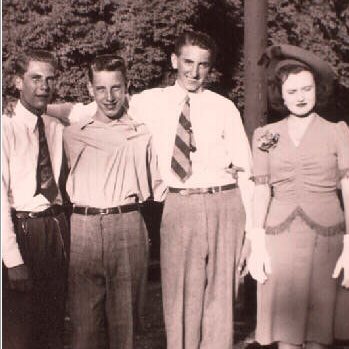
Courtship
Before Tom left for the Navy Reserves, he generously told Frances that she could date other people while he was gone. He later asked himself, “what was I thinking?” When Tom came home on leave after basic training, he called her for a date, only to discover she already had one for the evening. Tom told Frances to break it off, but she refused. Even though they would go out together for many of the remaining days of his leave, Tom took back his suggestion that Frances date other people.
Tom and Frances wrote to each other while he was in the Reserves. After the war ended, they began to date more seriously. He purchased a ring to propose with and showed it to his family. Tom picked up Frances, and they stopped by his home before leaving on their date. However, the surprise was ruined when Tom’s four year old brother, Scott, eagerly announced, “Tommy has a ring for you, Frances” (To the Rescue).
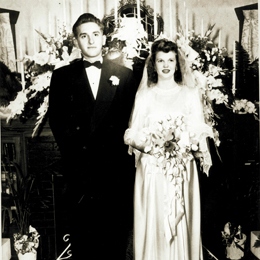
Spiritual Growth
“A Child’s Prayer”
Tom began to earn money when he was 12 years old by doing odd jobs in the print shop where his father worked. One day, Tommy put a five dollar bill he had just earned into his pants’ pocket. The inevitable happened, and he forgot it was there until too late. His pants had been sent off to the laundry with the precious money inside, heading towards imminent destruction.
But young Tommy had faith and earnestly prayed to God that his five dollar bill would somehow manage to survive the dreaded wash. He anxiously awaited the clothing’s return. When he got his pants back, Tommy found his money wet, but otherwise intact. Tommy prayed in thanks, knowing that God listened to all prayers, even those of children with simple needs (General Conference talk “Standing in Holy Places” ; To the Rescue).
A Worthy Priesthood Holder in the Military
World War Two raged in Europe. It seemed likely that Tom would get drafted, so he joined the Navy Reserves. He received the Melchizedek priesthood before leaving for basic training, and when John Burt of the bishopric came to see him off, he gave Tom a missionary handbook. Tom pointed out that he was not going on a mission, but Brother Burt said, “take it anyway. It may come in handy.”
Though many of his comrades did not keep the commandments in the Reserves, Tom never betrayed his faith. He did not realize the importance of his choice to stay worthy of his priesthood until a friend of his, Leland Merrill, became ill the evening before their Christmas leave. Though Leland felt very sick, he did not want to go the base dispensary because the doctors there would keep him from going home.
However, as the evening progressed, Leland only got worse. He asked Tom to give him a blessing. Tom had never given a blessing to heal the sick before; he had not even seen if done. Tom didn’t know what to do, so he prayed for help. He felt impressed to look in the bottom of his bag, and there he found the missionary handbook complete with instructions on giving blessings. Leland was healed and able to return home for the leave (General Conference talk “The Priesthood—a Sacred Gift” ; To the Rescue).
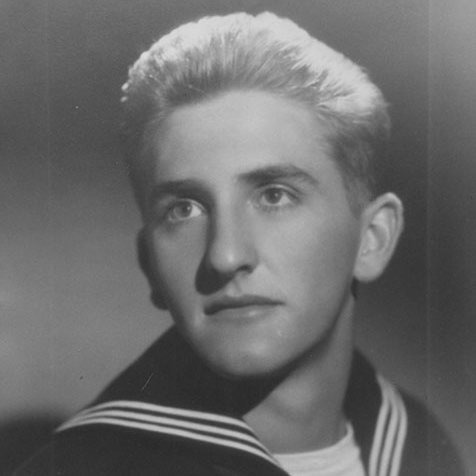
Lessons Learned
Halloween Prank
When Tommy and his deacon friends found a straw dummy, it seemed as if they had hit the jackpot of all pranks. They threw the dummy in front of cars, so the drivers would think they had hit a person. When the boys tossed the dummy in front of a bus, the driver slammed on his breaks so hard that the passengers screamed and one woman fainted.
Tommy and his friends were having a blast until word got out to John Burt, a counselor in the bishopric. He confiscated their straw dummy, intending to burn it in a furnace. The boys retaliated, threatening to refuse to pass the sacrament that Sunday if he destroyed their dummy. Brother Burt’s responded saying, “how you act on Sunday is up to you. How I act is up to me.”
That Sunday, Tommy and the rest of the deacons did not sit in their usual places to pass the sacrament. But as they thought of Brother Burt’s words earlier that week, they eventually humbled and took their places as priesthood holders (To the Rescue).
Duck Hunting and Keeping the Sabbath Holy
The weather was perfect for duck hunting. Despite the fact that it was Sunday, Tom and his brother, Bob, could not resist the opportunity. Even though Tom had just been called as a bishop, he was my no means perfect and decided a duck hunt on Sunday wouldn’t cause any harm.
The brothers set out on a rowboat and landed on a sandbar. Bob got out of the boat and slipped, falling on the wet sand. At that exact moment, a gun fell off of a bench in the boat and discharged, shooting right where Bob had been a mere second before.
The two brothers were silent for several long moments. Finally, Tom said, “let’s go home.” Tom and Bob never hunted or fished on Sunday again. Tom recognized that the near-accident was a chastening from the Lord, and learned from his mistake (To the Rescue).
Following the Promptings of the Spirit
One of the most significant lessons Tom learned in his life also came with sorrow. This experience happened when he was a bishop. He received a call informing him that an older member of the ward was in the hospital and would like a blessing. Tom promised to stop by after he attended a stake meeting.
But at the meeting, Tom kept receiving the strongest prompting to leave immediately and go to the hospital. However, he did not want to be disrespectful, so he stayed. The prompting only grew stronger and more persistent as the meeting continued. Tom waited and waited, finally leaving right before the closing prayer, rushing to the hospital.
When he arrived, a nurse surprised him by asking if he was Bishop Monson. When he told her he was, she said, “I’m sorry. The patient was calling your name just before he passed away.” Tom was strongly affected by this experience. That evening, he promised himself that he would never ignore a spiritual prompting again (Liahona article “President Thomas S. Monson: In the Footsteps of the Master”).
Becoming a Leader in the Church
Birds of a Feather in the Teacher’s Quorum
One of the activities Tommy loved best as a youth was raising pigeons, and he often won prizes for them. When he was teacher’s quorum president, his adviser gave him two injured pigeons. Tommy managed to train one of them to return to his coop, but a one-eyed female flew back to his adviser’s home.
When he went to retrieve the pigeon, the adviser spoke with Tommy about an inactive boy in the quorum. Tommy told his adviser that he’d talk to the boy and get him to church next Sunday, and he did just that. Though no matter how hard Tommy tried, he could not train that pigeon to return to his coop. Every time Tommy went to get his pigeon back, he had the same discussion with his adviser about the inactive boys in the quorum. Monson later said that:
My adviser, had given me a special pigeon, the only bird in his loft he knew would return every time she was released. It was his inspired way of having an ideal personal priesthood interview with the teachers quorum president every two weeks. Because of those interviews and that old one-eyed pigeon, every boy in that teachers quorum became active
Tommy recognized that his adviser helped him to become a strong, spiritual leader in his quorum, training him to become a leader in the Church (“Thomas S. Monson”).
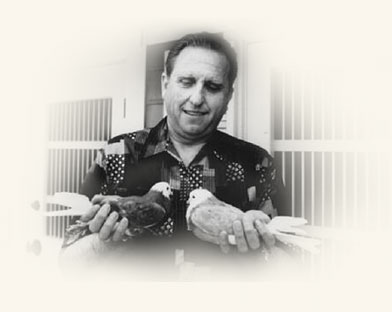
“Decisions Determine Destiny”
After his marriage and college graduation, Tom rejoined the Navy Reserves and was offered a commission of an Ensign, an opportunity he wanted to take. At the same time, he was called as a counselor in his bishopric. He realized that bishop’s counsel was the same evening as navy drill. Tom would have to choose between the two.
He went to his boyhood stake president, Harold B. Lee, for advice. Lee not only told him to refuse the commission, but to leave the Reserves as well. This wasn’t exactly the answer Tom wanted. Even when he protested, explaining that the Navy would never discharge him because of the war in Korea, and that he would rather go there as a commissioned officer, Lee insisted and said, “the military is not for you.”
The Navy opportunity would be a difficult one for Tom to give up, especially in the face of an uncertain future. However, he had trust in Harold B. Lee’s advice and trust in God. Tom did all that Lee had advised him to, and surprisingly had no trouble with the Navy discharge he thought would prove impossible. Tom realized the importance of his choices six weeks later when he was made a bishop (To the Rescue).
Tom was only 22 years old when he was called as bishop to a ward with 1,080 members, 84 of whom were widows (“Thomas S. Monson”). But Tom did his duty for his ward and lead with faith in God. He also grew close to each of the widows in the ward and would speak at all 84 of their funerals (Liahona article “President Thomas S. Monson: In the Footsteps of the Master”).
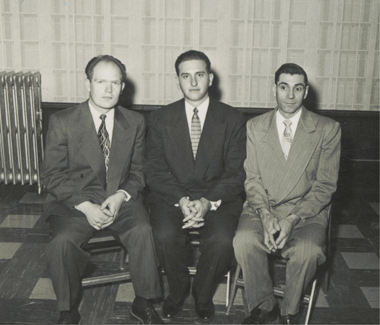
After He Was Called as a Prophet
Thomas S. Monson held several callings after being a bishop, including counselor in his stake presidency, mission president for the Canadian Mission, and member of general church committees. He held a career in the publishing industry, spending many years working for Deseret News Press. Tom and Frances would raise three children, and later have eight grandchildren and eleven great-grandchildren (“President Thomas S. Monson”).
On October 10, 1963, Tom received the call of an apostle at the shockingly young age of 36—the youngest called since 1910. One of his most significant accomplishments while as an apostle was obtaining permission to build a temple and allow missionaries into the German Democratic Republic while it was still behind the iron curtain (“Thomas S. Monson”).
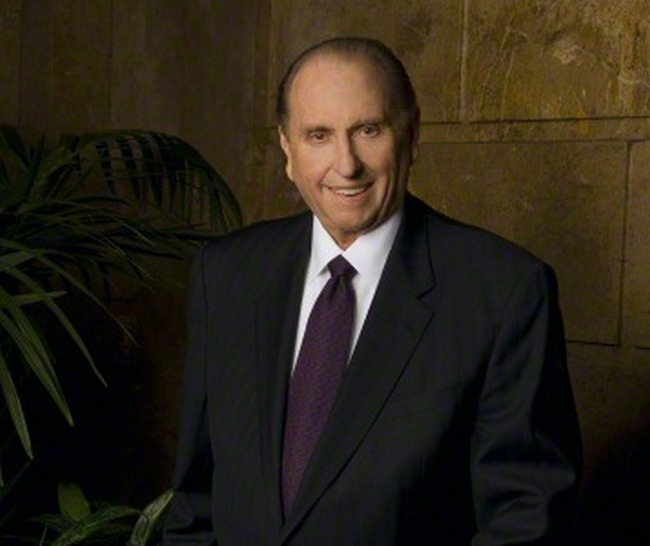
Thomas S. Monson had served as a member of the First Presidency since November 10, 1985. Since that day he has dedicated or rededicated 25 temples and announced the construction of 44 temples. On February 3, 2008, he was called as the 16th president of the Church (“President Thomas S. Monson). Throughout his service in the church, he emphasized service towards others. In the article “President Monson: Service Brings Joy,” he says that:
To find real happiness, we must seek for it in a focus outside ourselves. No one has learned the meaning of living until he has surrendered his ego to the service of his fellow man. Service to others is akin to duty, the fulfillment of which brings true joy.
Having served for over 54 years, he is 5th on the list of longest-serving apostles—after David O. McKay (63 years), Heber J. Grant (62), Joseph Fielding Smith (62), and Wilford Woodruff (59).
President Monson has been a stalwart example of service throughout his life and his calling to the Church. The experiences of his youth helped him grow in love, charity, faith, and leadership.
To learn more about President Monson, visit his Facebook page or going to these links.
- Thomas S. Monson’s biography To the Rescue
- A Fitting Tribute from Religion News Service
- LDS.org article “Thomas S. Monson”
- LDS.org article “President Thomas S. Monson”
- Liahona article “President Thomas S. Monson: In the Footsteps of the Master”
- Presidents of the Church student manual chapter “Thomas S. Monson: Sixteenth President of the Church”



